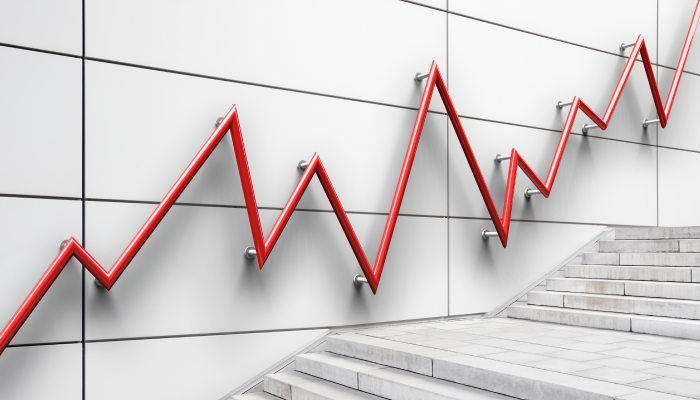Key performance indicators (KPIs) are values that measure an organization’s success at meeting its objectives. They do so by providing insight into business conditions like predictability, early return on investment (ROI), product quality, and more.
In practice, KPIs measure how a company will strategically grow.
However, behind every KPI is the implication that current conditions influence trends and inform predictions for future growth. Leading and lagging indicators are qualifiers that assess a business’s current state (lagging indicator) and predict future conditions (leading indicator), so companies can achieve accurate projections.
In the following article, we’ll discuss leading and lagging indicators: what they are and how to use them.
What are leading and lagging indicators?
Leading and lagging indicators help enterprise leaders understand business conditions and trends. They are metrics that inform managers that they are on track to meet their enterprise goals and objectives.
Leading indicator
Leading indicators are sometimes described as inputs. They define what actions are necessary to achieve your goals with measurable outcomes. They “lead” to successfully meeting overall business objectives, which is why they are called “leading”.
A leading indicator encourages business stakeholders to ask:
- What processes can I employ to achieve this goal to higher levels of success?
- What skills can the team improve to better achieve the desired outcome?
- What steps can be taken to speed up product development?
Leading indicators do this by providing benchmarks that, if met, will be indicative of meeting overall KPIs and objectives. Some examples of leading indicators for an enterprise business software company with an annual subscription fee might be:
- Percent of customers that sign up for two-year agreements
- Number of customers that renew software at or before mid-term alerts
- Number of customers that purchase software add ons
Lagging indicator
If a leading indicator informs business leaders of how to produce desired results, a lagging indicator measures current production and performance. While a leading indicator is dynamic but difficult to measure, a lagging indicator is easy to measure but hard to change. They are opposites, and as such a lagging indicator is sometimes compared to an output metric.
A lagging indicator encourages business stakeholders to ask:
- How many people attended an event?
- How much product was produced?
- What response did it receive?
Lagging indicators measure output that’s already occurred to gain insight on future success. They do this by measuring things like:
- Profit
- Expenses
- Customer participation
- Renewal rates; and
- Revenue
How to use lagging indicators
Lagging indicators are always triggered by an event that has just occurred, and, in that sense, are a little more self-explanatory than leading indicators.
If you’re measuring the outcome of an event, product release, sales training program or what have you, you’re using lagging indicators to determine, in retrospect, who attended, what was produced, or how it was received by attendees.
Lagging indicators are best used in conjunction with leading indicators to determine trends and if outcomes were met. This can be made simple with the right technology infrastructure that compares leading and lagging indicators, offering insight.
How to use leading indicators
Leading indicators are trickier to measure than lagging indicators. That’s because they tend to be more abstract.
As mentioned, a leading indicator is a measure of where your business is going. For instance, if you stick to lagging measurements, like revenue, you may completely miss an important, but relatively small, segment of your market that is purchasing from another geographical location in which you don’t have a presence.
That’s where leading indicators enter the scene. By creating measurements like tracking individual purchases outside of certain zip codes or regions, you can learn where your company could potentially establish a new foothold.
That’s an insight you can’t understand by looking at overall revenue alone. When you have a question that asks you to look into future growth and success, it’s the right time to use a leading indicator.
Example of lagging indicators in practice
Since lagging indicators measure what’s already occurred, they can be a useful business asset. However, some enterprise organizations rely too heavily on lagging indicators because they are so much easier to measure. As such, they don’t spend a lot of time working on leading indicators.
A best practice is to deploy both. Here are some examples of lagging indicators so you can see how to use them in practice, and how they interact with leading indicators:
The Corporate Retreat
Imagine you’ve just organized a corporate retreat and you’re trying to determine if it was successful. One way you can do that is by using lagging indicators like:
- How many people attended the retreat?: This can give you an idea of general interest.
- How much money did the retreat cost?: This is helpful to calculate the ROI
- How many of the attendees signed up for workshops?: This metric tells if your programming was engaging.
- Which workshops had the most attendees?: This indicator implies which parts of the program were most interesting.
Example of leading indicators in practice
Leading indicators may be harder to measure but the offer valuable insight about the future. They work with lagging indicators to create a number of metrics that are key performance indicators of future growth.
The Corporate Retreat
For example, in the previous section, we decided on some lagging indicators from a fictional corporate retreat. One of those indicators was, “how much did the retreat cost?” Imagine the retreat was a sales training seminar and business leaders want to use this lagging metric to determine the potential for ROI in three months, six months and one year.
What values do they need to do that? The answer is they need to calculate leading indicators that determine sales revenue growth in three months, six months, and one year. Once they have those figures, they can measure them against the cost of the retreat to project future ROI over the course of a one-year sales cycle.
Here are some more other leading metrics that might be associated with a retreat of this nature:
- Where can we expect the most sales growth?: Based on attendance and other factors, this indicates what new regional or industry markets you can corner after the retreat.
- What individuals sales goals can we predict in new markets?: Given that you expect to grow in certain areas, this percent of growth indicates how much to expect
- What attendance can we expect at next year’s conference? Using lagging indicators like total attendance, managers can come up with leading indicators like percent of future attendance.
The end game strategy
The bottom line is if you’re using lagging indicators without leading indicators, you’re only getting half of the KPI picture. Lagging indicators are an important resource for creating leading indicators that can launch your business into growth mode, but they aren’t the entire package. These sets of metrics work best in tandem to produce the most accurate and achievable KPIs.







